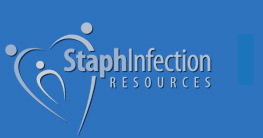This is the first of a 2 part series on the use of Chlorhexidine as a skin wash and MRSA decolonization protocol.
In the news lately are more scientific studies confirming the level of resistance of MRSA and Staphylococcus aureus bacteria against the antiseptic skin cleanser called chlorhexidine gluconate, or CHG. Chlorhexidine gluconate washes are commonly prescribed to help prevent MRSA infections and help in skin decolonization for MRSA. CHG is normally well tolerated, but it does have some important precautions you should know about, including some occasion serious side effects.
What is Chlorhexidine and what is it used for?
Chlorhexidine is an antiseptic which works against a broad range of bacteria. The term antiseptic means that it’s a product meant to inhibit and kill bacteria on mucous membranes, body tissues or skin. This is different than chlorox (bleach), which is a “disinfectant” meant to kill bacteria on hard surfaces, like counter tops or bathtubs. Chlorhexidine skin preparations go by many names, including Hibiclens, Hibiscrub and Savinox. In the U.S., it is now available without a prescription.
Chlorhexidine is routinely used in hospitals and health care environments for general skin and hand cleansers, as a pre-surgical skin scrub, and as a pre-operative skin cleanser to reduce or kill skin bacteria on the surgical site. It’s used to prevent the spread of hospital acquired infections. Chlorhexidine is also added to catheters to reduce bladder infections. It’s also an active ingredient in some mouthwashes to reduce dental plaque and gingivitis. It is also commonly used as part of a MRSA decolonization procedure as a skin wash and as a mouthwash.
MRSA colonization – what does it mean?
Colonization means that the bacteria are living on your skin and/or inside your nose, but are not causing an active infection. People who are colonized carry a higher risk of getting infected, and they can pass these bacteria to other people. Colonization is typically verified by testing inside your nose for the presence of MRSA or Staph aureus bacteria. Colonization testing can also include checking armpits and areas around your groin. Testing may also include a throat culture as some data indicate this may be a better indicator than the nose for testing.
Many studies have shown chlorhexidine to be effective at reducing the rate of hospital acquired infections, including MRSA and VRE. Studies also show that skin sponge baths using chlorhexidine solutions have reduced colonization of MRSA bacteria. Testing is usually performed if you’ve had a MRSA infection before, if a member of your family has MRSA, or if you are scheduled for surgery.
Chlorhexidine for MRSA decolonization protocols
If you are tested and found to be a MRSA carrier, decolonization with chlorhexidine is commonly prescribed. Decolonization is defined as the elimination of MRSA carriage, but definitions differ in how long the bacteria are eliminated in order for the therapy to be successful. Recolonization of MRSA bacteria is fairly common in the long term. Failure to decolonize is due to many factors, and can include a history of MRSA infections, family members with infections, and resistance to chlorhexidine or mupirocin.
Decolonization procedures typically include skin baths with a chlorhexidine soap product for 3 days as well as nasal application of the topical antibiotic cream mupirocin for 5 days. Sometimes antibiotics are also prescribed. Skin and/or nose cultures are taken again after the decolonization procedures are performed to see if the MRSA or Staph bacteria are still present. If they are gone, decolonization is considered a success.
Be sure to follow your doctor’s specific orders on how to use chlorhexidine as usage can vary from person to person and by age.
Growing chlorhexidine MRSA resistance – Are there other options?
There are many studies available showing that MRSA strains are more resistant to chlorhexidine, and have garnered this resistance over the last few years. Chlorhexidine resistance among bacteria, including MRSA and many other types of bacteria, is troubling because resistance factors can be transferred to other bacteria, creating superbugs. And of course, chlorhexidine resistance can cause a decrease in effectiveness of chlorhexidine decolonization procedures, which can reduce the control of MRSA.
Some people prefer to avoid these issues by choosing alternatives to chlorhexidine to reduce bacteria on their skin and in their nose. I’ve heard from many people who’ve started using natural products and essential oils and have been decolonized from MRSA. These protocols can include the use of tea tree, lavender or other essential oils.
Unlike chlorhexidine, there is little to no issue with antibacterial resistance using high potency medicinal quality oils. These oils have a long safe history of use when used in a correct manner and with correct quality. This is part of a comprehensive holistic approach to MRSA in my program “MRSA Secrets Revealed“.
Stay tuned for my next article covering possible side effects and precautions when using chlorhexidine.
To your best health,
Michelle Moore
Health expert and Author the MRSA Treatment Program MRSA Secrets Revealed
References:
Low-Level Mupirocin, Chlorhexidine Resistance Thwart MRSA Control in Hospitals, Dr. Andie S. Lee, FROM THE ANNUAL INTERSCIENCE CONFERENCE ON ANTIMICROBIAL AGENTS AND CHEMOTHERAPY 2010
Limited effectiveness of chlorhexidine based hand disinfectants against methicillin-resistant Staphylococcus aureus (MRSA). J Hosp Infect. 1998 Apr;38(4):297-303.




